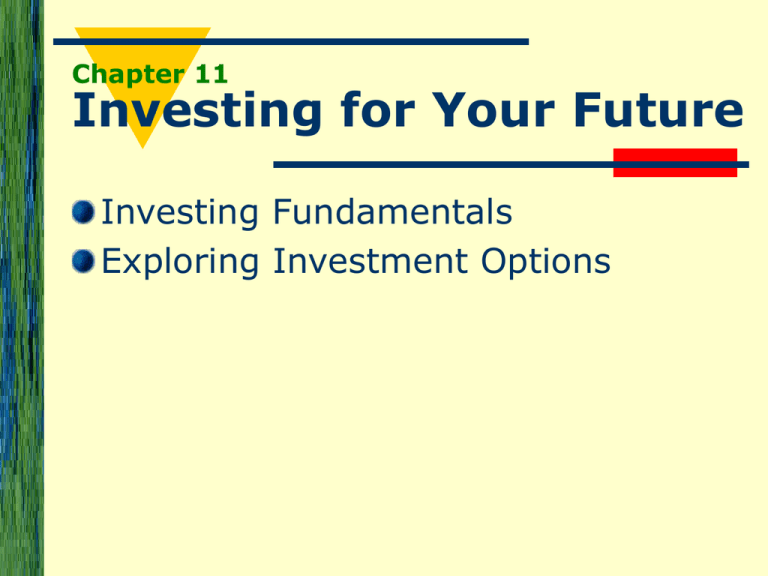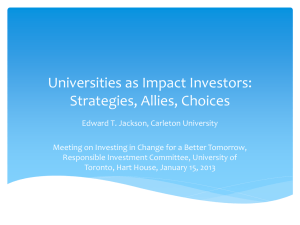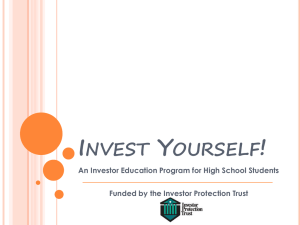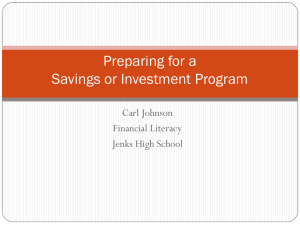Chapter 11 Investing for Your Future
advertisement

Chapter 11 Investing for Your Future Investing Fundamentals Exploring Investment Options Lesson 11.1 Investing Fundamentals GOALS Describe the stages of investing and the relationship between risk and potential return. Explain effective investment strategies, criteria for choosing an investment, and steps for investing wisely. Stages of Investing Stage 1. Put-and-take account First get a job Use your money to pay bills and start an “emergency” fund Put two paychecks worth into savings to use when car breaks down, medical bills, other larger expenses. Stage 2. Beginning investing Start conservatively and low risk in your 20s Maybe buy some mutual funds or stocks for “fun” Stages of Investing Stage 3. Systematic investing Set aside a specific amount of money to invest each month Should really start in your 20s and continue into your 30s Set up an IRA (Individual Retirement Account), contribute to employer-sponsored 401(k)’s and 403(b)’s Roth IRA Invest post-tax dollars Earnings grow tax free When you start drawing money at retirement, you are not taxed GET A ROTH IRA AND CONTRIBUTE THE MAXIMUM ALLOWED EACH YEAR! Stages of Investing Stage 4. Strategic investing In your 40s and 50s you need to more actively manage your investments Move some riskier investments to more conservative as you get closer to retirement Portfolio – your collection of investments Always want to diversify (or mix up) what you are investing in – reduces risk Stage 5. Speculative investing Final stage – make or break You have either made or lost a lot of money Don’t make a risky investment to try to make up for previous losses! Reasons for Investing Investing helps beat inflation. Investing increases wealth. Investing is fun and challenging. Risk and Return Diversification Don’t invest in only one company or one sector of economy (banking, transportation, retail, etc.) Types of risk Interest-rate risk Occurs during times of high inflation Inflation makes your fixed-rate investments worth less Fixed-rate bond at 3% and inflation rate is 6% not so good Fixed-rate bond at 6% and inflation rate is 3% better Risk and Return Types of risk (continued) Political risk Governmental policies can affect business decisions Increased taxes on businesses or environmental restrictions can make some investments less attractive Market risk Sudden world events affect entire market The Great Depression, September 11th Company or industry risk Certain businesses or industries are affected by national trends Adkins diet was good for the cattle industry – the price of beef increased! Criteria for Choosing an Investment Safety Little chance of losing initial investment Low risk bonds, savings accounts, CDs High liquidity Accessing your money quickly Savings account, money market fund, CDs Low liquidity means that it takes a little longer to cash out of your investment Real estate, stocks, mutual funds, collectibles Criteria for Choosing an Investment High dividends or interest Dividends are distributed to shareholders based on company profits If dividend is $0.25 per share and you own 100 shares, you would receive a dividend of $25.00 Look at previous financial records (annual report) to see dividend history Growth in value that exceeds the inflation rate Inflation has increased 58% since 1982 Criteria for Choosing an Investment Reasonable purchase price Stock might be undervalued Good buying opportunity if you think that it will increase in price Remember there’s no guarantee! Tax benefits You will have to pay taxes on investment earnings – unless you invest in tax-exempt mutual funds or bonds Tax-exempt bonds have a lower interest rate, which is offset by the tax benefits Usually only high-net worth individuals purchase tax-exempt investments Wise Investment Practices Define your financial goals. Saving for first home, retirement, college Go slowly. Research investments – don’t buy on impulse Follow through. Start saving now - take advantage of the benefits of compound interest! Best bet is to have money taken directly from checking account each month Wise Investment Practices Keep good records. Hold on to monthly/quarterly statements For tax purposes you will need to have record of the purchase price of investments This is called the cost basis Seek good investment advice. If need be, hire a certified financial planner Listen to Money Talk on the radio http://www.bobbrinker.com/ Wise Investment Practices Keep investment knowledge current. Again, listen to Money Talk Good investments now, may not be good investments in the future Watch world events and pay attention to economic changes Know your limits. Know your risk tolerance and what you can afford Be weary of “get rich quick” investments that sound too good to be true Lesson 11.2 Exploring Investment Options GOALS List and describe sources of financial information useful for making investment decisions. List and define basic investment options, rated by risk. Sources of Financial Information Newspapers have financial pages that keep track of the financial market Papers that are specific for the financial market Wall Street Journal, Barron’s, The Bond Buyer Investor’s services provide extensive data to clients Moody’s Investors Services and Standard & Poors Sources of Financial Information Financial Magazines Fortune, Business Week Full-service broker Provide clients with investment advice based on their specific needs/risk tolerance Raymond James, Merrill Lynch, Smith Barney Discount brokers Buy and sell securities for customers at a reduced cost Little or no advice Ameritrade, TD Waterhouse Sources of Financial Information Financial Advisor Trained professional investment planners Look at your goals, age, net worth, occupation, etc to determine what investments you should make Annual Reports Summary of a company’s financial results Securities and Exchange Commission (SEC) requires all corporations to provide to stockholders each year Sources of Financial Information Trade yourself online (E-trade) You do your own research Costs about $5 a trade, but you are limited to only 10 trades a year More than 10 trades and its more expensive Costs to buy and sell (trade) depend on several factors Commission, flat rate or per trade cost Investment Options Low risk: low-to-medium return Medium risk: medium return High risk: high return Low Risk: Low-to-Medium Return Corporate and municipal bonds U.S. government savings bonds Treasury securities Treasury bills – mature in one year or less Also referred to as t-bills Treasury notes – mature in 2 to 10 years Treasury bonds – mature from 10 to 30 years Medium Risk: Medium Return Mutual funds Annuities Contract sold by an insurance company that provides the investor with a series of regular payments These have ENOURMOUS fees! Self-managed retirement accounts The risk of the IRA depends on the particular investments Real estate High Risk: High Return Stocks Owner is called the stockholder When the company makes a profit this is paid to stockholders in the form of dividends Futures Buy and sell commodities or stocks for a date in the future You can also buy just commodities When you sell you are betting the price will go down, when you buy you are betting the price will go up http://www.bloomberg.com/markets/commodities/cfutures .html Options Puts and calls The right (not obligation) to buy or sell a commodity or stock for a specific price for a set amount of time High Risk: High Return Penny stocks Extremely low priced stocks of small companies with or without a proven track record Usually costs less than a dollar Many fail and become worthless Collectibles You need to make sure that there is a buyer for what you are collecting Annual Reports Published by “public” companies for shareholders to view Legally required and shows all financial records Important parts to look at Income statement Are sales (revenue) increasing? Do they have low operating expenses? Building, payroll, maintenance, etc. Do they have a lot of interest expense/income? What’s their net income (revenue – expenses)? One of most important items for a stockholder! Stock Common Stock Own share of company and have a voting right Only receive dividends if company makes profit Preferred Stock Own share of company but have no voting rights Pay dividend monthly or yearly regardless of the profitability of company Shares Outstanding Number of shares available for trading Companies can change this amount Effects supply and demand which in turns affects the price of the stock






